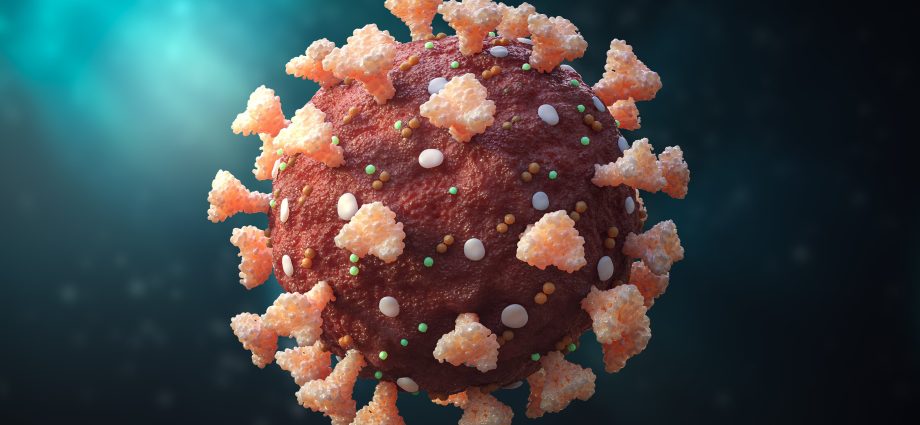Tse ka Hare
Omikron and Delta could hit people at the same time and combine to create an even worse variant of the coronavirus. And it may happen in the coming weeks – warns Moderna company expert. The result of such a combination could be a completely new and dangerous superwariant – informs dailymail.co.uk.
- Moderna’s expert warns against the possible recombination of two variants of the coronavirus, currently dominant, among others in Great Britain and USA
- Delta and Omikron can join forces, swap genes, and create a new superwariant that may be more dangerous than its predecessors
- The Omikron variant appeared most likely as a result of chronic infection in an immunocompromised person. This allowed the virus to mutate several times and, as a result, spread faster among people
- Lintlha tse ling li ka fumanoa leqepheng la lehae la TvoiLokony
A new superwariant could arise, if Omikron and Delta attacked someone at the same time, says Dr. Paul Burton, Moderna’s chief physician. This can infect the same cell and replace genes. Such cases are relatively rare, but the current high numbers of both Delta and Omicron infections in the UK increase the likelihood of this happening. Experts warn that these so-called coronavirus recombinations are possible, but require very specific conditions, incl. reduced immunity.
Mongolo o tsoela pele ka tlase ho video:
- Patlisiso e ncha: Omicron e ata ka potlako empa e kanna ea se be kotsi joalo ka ha ho lebelletsoe
So far, recombinations have been harmless
So far, three variants have been recorded due to the combination of two others. However, none of them led to an uncontrolled outbreak or the emergence of a more dangerous version of the virus. On one occasion a recombination event took place in Great Britain when variant Alpha merged with B.1.177which first appeared in Spain at the end of January. This led to 44 cases of infections.
In turn, scientists from California in early February identified another variant of recombination: Kent strain merged with B.1.429, which was first noticed in this area. This new strain also led to very few cases and quickly disappeared.
In the UK, the risk of gene exchange between Omicron and Delta is increasing
Omikron already dominates London just two weeks after it was spotted in the country, and experts estimate it will be the main strain of the COVID-19 virus by New Year. The fact that the two variants of the virus are now mixing in the country increases the risk of recombination and replacement of genes and, as a result, the creation of a new virus variant. Dr Burton said in a House of Commons meeting that he had seen data from South Africa, for example, that immunocompromised people could carry both viruses – reports dailymail.co.uk. He added that this is also possible in Great Britain. When asked if this could lead to a more dangerous variant, he said “certainly yes.”
- Omicron e hlasela ea entetsoeng. Moprofesa oa lefu la seoa o senola hore na matšoao ke afe
Superwariant – Unlikely, but Possible
Experts believe that in healthy people, it takes about two weeks from the time of infection to develop immunity and effectively remove the virus. It is unlikely that the infected will be attacked by another variant during this time. However, the higher the number of infections in a country, the greater the risk of recombination.
Experts estimate that the Omikron variant appeared as a result of chronic infection in an immunocompromised person. This allowed the virus to mutate several times to learn to better infect humans and overcome their immunity, also acquired through vaccination. Such mutations occur randomly and in most cases do not bring significant changes, nor are they particularly harmful. But you never know – at any moment there may be a variant stronger than all the previous ones.
A na u batla ho etsa tlhahlobo ea boits'ireletso ba hau ba COVID-19 kamora ho entoa? A na u tšoaelitsoe 'me u batla ho lekola maemo a hau a antibody? Sheba sephutheloana sa tlhahlobo ea ho itšireletsa mafung ho COVID-19, seo u tla se etsa libakeng tsa marang-rang tsa Diagnostics.
Hape bala:
- United Kingdom: Omikron e ikarabella ho feta liperesente tse 20. mafu a macha
- Rekoto ea ts'oaetso e ncha Great Britain. Boholo ka likhoeli tse 11
- 'Mapa o mocha oa ts'oaetso ea COVID-19. Boemo ba tlokotsi hohle Europe
Litaba tsa webosaete ea medTvoiLokony li reretsoe ho ntlafatsa, eseng ho nkela sebaka, khokahano lipakeng tsa Mosebelisi oa Webosaete le ngaka ea bona. Sebaka sa Marang-rang se etselitsoe merero ea tlhahisoleseling le thuto feela. Pele u latela tsebo ea setsebi, haholo-holo keletso ea bongaka, e fumanehang ho Websaete ea rona, u tlameha ho buisana le ngaka. Mookameli ha a jare liphello leha e le life tse bakoang ke tšebeliso ea boitsebiso bo hlahang Websaeteng. Na u hloka tlhahlobo ea bongaka kapa lengolo la ngaka? Eya ho halodoctor.pl, moo o tla fumana thuso inthaneteng - kapele, ka polokeho le ntle le ho tloha lapeng la hau.










